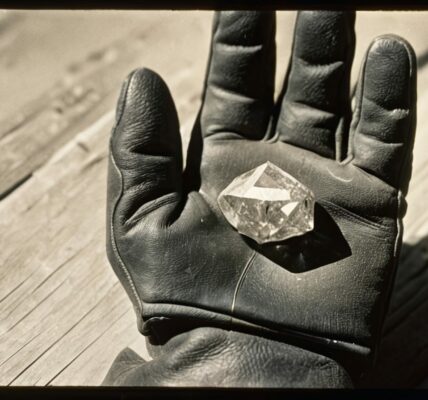The Natural Diamond Industry’s Awakening: Hope For a Brighter Future?
TL;DR:The diamond industry post-JCK shows signs of a comeback for natural diamonds amidst challenges and uncertainties.
Amidst the shifting tides of the diamond industry, whispers have emerged post-JCK, hinting at a potential revival of natural diamonds. This article examines the subtle signs of this resurgence, the challenges faced by the industry, and the strategic maneuvers by key players. In recent years, lab-grown diamonds have been steadily gaining market share, posing a significant threat to the natural diamond market. However, the Indian diamond industry revival has sparked hope for a turnaround. With key players investing in technology, marketing, and sustainability, the natural diamond market may see a resurgence in the coming years.
Article Contents
Introduction to the Natural Diamond Resurgence
In the realm of natural diamonds, whispers have begun to circulate, hinting at a potential renaissance in the industry. Following the prestigious JCK event, subtle indications of a turnaround have emerged, sparking optimism among industry insiders. The significance of natural diamonds in the market landscape cannot be understated, as they continue to hold a unique allure and enduring appeal.
Amidst the challenges faced by the diamond business, there is a glimmer of hope for the natural diamond sector. Post-JCK, there has been a palpable shift in sentiment, with a slight uptick in retail sales signaling a possible resurgence. While the journey towards recovery is still in its early stages, the industry is beginning to acknowledge the importance of natural diamonds in shaping its future trajectory.
The events following JCK have underscored a collective effort within the industry to promote and celebrate natural diamonds. From the Diamonds Do Good dinner to engaging conversations with key figures like Botswana President Mokgweetsi Masisi, there is a renewed focus on highlighting the intrinsic value of natural diamonds. This concerted push reflects a growing awareness of the need to champion the authenticity and allure of natural diamonds in a market that is constantly evolving.
During a pivotal De Beers event, CEO Al Cook candidly addressed the challenges confronting the industry in the wake of recent successes. The period of growth during the COVID era brought both lab-grown and natural diamonds into the spotlight, leading to a surge in competition for market share. However, instead of fostering collaboration, the two segments found themselves engaged in a counterproductive rivalry, resulting in setbacks for both sides.
While lab-grown diamonds experienced a surge in popularity, recent trends indicate a waning interest as venture capital funding for many brands dwindles. The future of lab-grown diamond consumer demand appears uncertain, with only select players like Pandora showing potential interest. This shift in dynamics presents an opportune moment for the natural diamond sector to capitalize on its unique position and differentiate itself in the market.
The industry’s response to the evolving landscape has been varied, with some retailers exploring innovative strategies to offer larger or superior gems at competitive prices. However, the sustainability of this approach remains a point of contention, given the impact on margins and consumer preferences. To navigate these challenges effectively, there is a growing call for a comprehensive roadmap or training module that equips industry players with the necessary tools to adapt to changing market dynamics.
As the spotlight shifts to De Beers, a stalwart in the diamond mining industry, the company finds itself at a crossroads. With uncertainties looming and discussions of a potential sale in the air, De Beers faces the imperative of demonstrating market growth to maximize its value. Renowned for its prowess in both mining and marketing, De Beers occupies a unique position that demands a strategic approach to leverage its strengths and secure its foothold in the industry.
The future trajectory of De Beers holds significant implications for the broader market, with industry players closely monitoring its strategic moves. As the natural diamond industry navigates through a period of transformation, the role of established entities like De Beers becomes increasingly pivotal in shaping the narrative of the industry’s evolution. The evolving dynamics underscore the challenges and opportunities that lie ahead, requiring industry stakeholders to adopt a forward-thinking approach to thrive in a rapidly changing landscape.
Challenges Faced by the Diamond Industry
As the diamond industry navigates through a period of transformation, several challenges have emerged that are reshaping the landscape for both natural and lab-grown diamonds. The competition between these two sectors has intensified, leading to a dynamic market environment where strategic moves and innovative marketing approaches play a crucial role. Consumer preferences are shifting, with younger generations placing greater emphasis on sustainability and ethical sourcing, further influencing purchasing decisions. Amidst this evolving landscape, female leaders in Diamond District are emerging as key players, driving innovation and championing transparency in both production and retail practices. Their impactful contributions are helping to redefine industry standards and foster a more inclusive and forward-thinking approach to the diamond trade.
Competition Between Natural and Lab-Grown Diamond Sectors
The rivalry between natural and lab-grown diamonds has been a focal point in recent industry discussions. While both segments have their unique selling points, the competition for market share has intensified, leading to a scenario where each sector is vying for consumer attention and loyalty.
The allure of natural diamonds lies in their timeless appeal, rarity, and emotional significance. On the other hand, lab-grown diamonds offer a sustainable and cost-effective alternative, appealing to environmentally conscious consumers and those seeking affordable luxury.
However, the challenge arises from the need for both sectors to coexist harmoniously rather than engage in detrimental competition. Collaborative efforts to expand the overall market space could prove beneficial for the industry as a whole, fostering growth and innovation.
Marketing Challenges for Lab-Grown Diamonds
One of the key hurdles faced by the lab-grown diamond sector is the evolving marketing landscape. As venture capital funding for many brands begins to dwindle, the future of lab-grown diamond consumer demand appears uncertain.
While some companies like Pandora show significant interest in lab-grown diamonds, the lack of a unified industry group poses a challenge for cohesive marketing strategies. The industry must adapt to changing consumer preferences and find innovative ways to position lab-grown diamonds in the market effectively.
Impact of Pricing Strategies on the Market
Pricing strategies play a pivotal role in shaping the diamond market dynamics. As retailers grapple with the challenge of balancing competitive prices with quality offerings, the industry faces a delicate balancing act.
While some retailers explore avenues to offer larger or superior gems at competitive prices, questions arise regarding the sustainability of such approaches. The impact on gross margin dollars and consumer preferences must be carefully considered to ensure long-term market viability.
Overall, the diamond industry stands at a crossroads where strategic decisions regarding competition, marketing, and pricing will shape its future trajectory. Adapting to evolving market trends and consumer demands is essential for industry players to thrive in a rapidly changing landscape.
Strategic Moves by Key Players
As the natural diamond industry undergoes a period of transformation and uncertainty, key players like De Beers are strategizing their next moves to navigate the evolving landscape. Let’s examine De Beers’ approach towards marketing and mining, explore the potential restructuring of the company, and delve into speculations on its future trajectory. One area De Beers is focusing on is its marketing strategy, with a greater emphasis on ethical sourcing and sustainability to appeal to a more socially conscious consumer base. In terms of mining, the company is exploring innovative technologies to improve efficiency and reduce environmental impact. Additionally, there are rumors circulating about a potential collaboration between Tanishq and De Beers, which could further expand their market reach and influence in the industry.
De Beers’ Approach Towards Marketing and Mining
De Beers, a renowned diamond miner with a rich history in the industry, has always been at the forefront of both mining and marketing. The company’s unique position as a vertically integrated entity sets it apart from its competitors. While traditional mining companies focus solely on extraction, De Beers has excelled in understanding consumer trends, creating demand, and shaping the market.
Despite facing challenges in recent years, such as the rise of lab-grown diamonds and changing consumer preferences, De Beers has continued to adapt its marketing strategies. The company’s ability to connect with consumers on an emotional level and emphasize the rarity and beauty of natural diamonds has been a cornerstone of its success.
Moreover, De Beers has been proactive in promoting sustainability and responsible sourcing practices, aligning with the growing demand for ethically mined diamonds. By highlighting its commitment to environmental and social initiatives, De Beers aims to appeal to a new generation of conscious consumers.
Potential Restructuring of De Beers
Amidst uncertainties surrounding De Beers’ future, there have been speculations about potential restructuring within the company. One of the key considerations is whether De Beers should focus primarily on its mining operations and outsource its marketing activities.
By streamlining its business model and divesting non-core assets like De Beers Jewellers and Element Six, the company could enhance its operational efficiency and profitability. There’s also the possibility of rebranding De Beers as an African-centric company with a strong emphasis on its mining heritage.
However, current indications suggest that De Beers is leaning towards maintaining its dual identity as both a mining entity and a high-end jeweler. The company’s CEO, Al Cook, has hinted at expanding De Beers Jewellers’ retail presence, despite challenges in turning a profit in the past.
Speculations on De Beers’ Future Trajectory
The future trajectory of De Beers remains a topic of intense speculation within the industry. As one of the most iconic diamond miners, De Beers’ decisions hold significant implications for the market as a whole.
Industry experts and observers are closely watching how De Beers will navigate the changing dynamics of the diamond industry. From potential partnerships to strategic expansions, the company’s future moves will shape its legacy and influence the broader market landscape.
As De Beers continues to evolve in response to market trends and consumer demands, its strategic decisions will play a crucial role in defining its position in the industry. The coming years are poised to be transformative for De Beers, with the company poised to make bold moves to secure its place as a leader in the natural diamond sector.
Uncertainties Surrounding the Future of the Industry
As the natural diamond industry navigates through a period of transformation and uncertainty, the future trajectory of key players like De Beers remains a topic of intense speculation and debate. With potential scenarios, acquisition speculations, and a myriad of challenges and opportunities on the horizon, industry stakeholders find themselves at a critical juncture where strategic decisions will shape the course of the industry’s evolution.
Potential Scenarios for De Beers
De Beers, a stalwart in the diamond mining sector, stands at a crossroads with various potential scenarios influencing its future direction. The industry eagerly anticipates the next chapter in the saga of this iconic diamond miner, recognizing the profound impact of its decisions on the broader market. From restructuring to potential acquisitions, De Beers’ strategic moves will undoubtedly reverberate throughout the industry.
Acquisition Speculations and Industry Reactions
The prospect of De Beers being up for sale has sparked a flurry of acquisition speculations and industry reactions. With potential suitors ranging from private equity firms to luxury brands, the acquisition landscape presents both opportunities and challenges for De Beers. Industry experts closely monitor these developments, considering the implications for market dynamics and the brand’s long-term strategy.
Challenges and Opportunities for Industry Players
Amidst the uncertainties surrounding the future of the industry, challenges and opportunities abound for industry players. From navigating shifting market trends to making strategic moves that drive growth and sustainability, stakeholders must exhibit foresight and adaptability in the face of evolving dynamics. The competitive landscape demands innovative solutions and collaborative efforts to overcome challenges and seize emerging opportunities.
In conclusion, the natural diamond industry stands at a pivotal moment characterized by uncertainties, transformations, and a quest for resilience. As industry players chart their course amidst the shifting tides, strategic decision-making, forward-thinking initiatives, and a commitment to industry sustainability will be paramount in shaping a future that embraces change and innovation. One way the natural diamond industry can demonstrate its commitment to sustainability and social responsibility is through the adoption of the SCS 007 diamond certification. This certification ensures that diamonds are sourced ethically and responsibly, providing consumers with confidence in the origins of their purchase. By embracing initiatives such as the SCS 007 diamond certification, industry players can contribute to a positive narrative for the natural diamond industry and help drive its evolution towards a more sustainable and responsible future.
As the natural diamond industry awakens from its slumber, the road ahead is filled with challenges and opportunities. The strategic decisions made by industry giants like De Beers will shape the narrative of the industry’s evolution. With uncertainties looming over the future of the diamond market, adaptability and foresight will be key for players to thrive in this dynamic environment.




